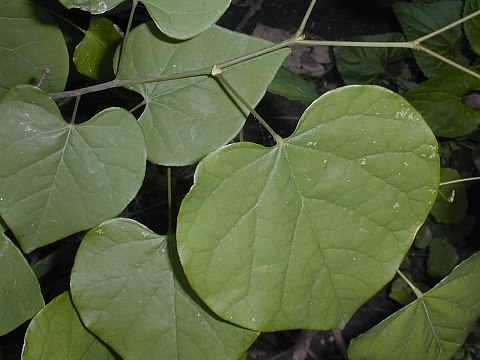Description: This woody plant is a shrub or small tree about 12-30' tall, forming a short trunk that is often crooked and a crown that is widely spreading and irregular. Trunk bark is gray and rough with flattened irregular scales and shallow furrows; the bark of branches is gray and more smooth. Twigs are brown, glabrous, and smooth; they are covered with small white lenticels. Young shoots are olive green and glabrous; they have a tendency to zigzag between the leaves. Alternate leaves develop along the shoots; their blades are 2½-5" long and about the same across. Individual leaf blades are oval-cordate or orbicular-cordate and smooth along their margins. Upper blade surfaces are medium green and glabrous, while their lower surfaces are pale green and either glabrous or slightly pubescent along the major veins and their axils. The slender petioles are 1½-4" long, light green, and glabrous (or nearly so).

Umbellate clusters of flowers and their buds develop along older branches before the leaves unfold. They are initially sessile during the bud stage, but individual flowers develop slender pedicels about 1" long when they bloom. The flowers are bright rosy pink while they are still in the bud stage, becoming pink to light pink as they bloom and age. As a result, Redbud remains attractive for about a month during the middle of spring. Individual flowers are about ½" long, consisting of a short tubular calyx, 5 petals, 10 stamens, and a pistil with a single style. Individual flowers have a pea-like floral structure, consisting of a central upper petal (the banner), 2 upper lateral petals (the wings), and 2 lower petals that form a projecting keel. The upper lateral petals are slightly larger than the central upper petal. The lower petals enclose the reproductive organs of the flowers. The irregular calyx has 5 blunt teeth; it is more purplish than the petals. During the summer, fertile flowers become transformed into flattened brown seedpods about 2-4" long and ½" tall. These seedpods persist on the tree or shrub through the fall and sometimes into the winter, eventually splitting apart to release their seeds. Individual seeds are a little less than ¼" long, somewhat flattened, and reniform (kidney-shaped). The woody root system produces a taproot and spreading lateral roots. Redbud reproduces by reseeding itself.

Cultivation: The preference is partial sun, moist to dry-mesic conditions, and soil containing loam, clay-loam, or some rocky material (especially limestone). Redbud is not normally found in an acidic sandy or peaty soil. This woody plant should be located in a protected area away from strong winds as its wood is prone to breakage, and it doesn't tolerate much flooding. Longevity is typically less than 75 years.
Range & Habitat: The native Redbud is common in southern and central Illinois, becoming uncommon or absent in the northern section of the state (see Distribution Map). Habitats include mesic deciduous woodlands, mixed rocky woodlands (deciduous & coniferous), wooded river valleys and riverbanks (above the flood stage), wooded slopes and slopes of ravines, savannas and thickets, limestone glades, and fence rows. To some extent, wildfires and other kinds of disturbance are beneficial to the maintenance of this species as this reduces excessive shade from canopy trees. Redbud is often cultivated in yards because of its attractive appearance.

Faunal Associations: The flowers of Redbud are pollinated primarily by bees, including honeybees (Apis mellifera), bumblebees (Bombus spp.), long-horned bees (Synhalonia spp.), cuckoo bees (Nomada spp.), mason bees (Osmia spp.), Andrenid bees (Andrena spp.), and Halictid bees (various spp.); also dance flies (Empididae) sometimes suck nectar from the flowers (Robertson, 1929). The bees are attracted to both nectar and pollen. Other insects feed destructively on the leaves, wood, or plant juices of Redbud. This includes the larvae of metallic wood-boring beetles (Buprestidae) and the larvae of long-horned beetles (Cerambycidae), and various leaf beetles (Chrysomelidae), including a seed beetle, the Redbud Bruchid (Gibbobruchus mimus); see McRae (1991), Yanega (1996), and Clark et al. (2004). Other insect feeders of this small tree include leafhoppers, armored scale insects, larvae of the Redbud Leaf-folder Moth (Fascista cercerisella), and larvae of a butterfly, Henry's Elfin (Callophyrs henrici); see Dietrich & Dmitriev (accessed 2010), ScaleNet (accessed 2014), Covell (1984/2005), and Opler & Krizek (1984). A more complete list of these insect feeders can be found in the Insect Table. Redbud is the primary host plant of the latter butterfly in Illinois. Among vertebrate animals, introduced populations of Elk feed sparingly on the leaves and twigs, while the Screech Owl occasionally selects this tree to roost in (Schneider et al., 2006; Belthoff & Ritchison, 1990).
Photographic Location: Crystal Lake Park in Urbana, Illinois.
Comments: Redbud is easily recognized by its bright pink flowers and broad cordate leaves. As a spring-flowering shrub or small tree, it remains attractive longer (about a month) than other woody species that typically bloom at about the same time of year. This is one reason for its popularity among landscapers and members of the public. There are other species in this interesting genus, but they are not found in Illinois. Some Robinia spp. (Locusts) also produce pea-like flowers in the spring, but their leaves are pinnately compound.